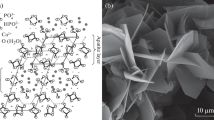Abstract
Tricalcium phosphate (TCP) ceramic is known in orthopedics to be a bioresorbable bone substitute. A porous TCP ceramic body also has high potential as a drug delivery system in bony defects. Porous α-TCP ceramic can be easily fabricated using conventional sintering of β-TCP, since α-TCP is the thermodynamically stable phase at temperatures above 1 100 °C. However, the solubility of α-TCP is much higher than that of β-TCP. Therefore, the dissolution of porous α-TCP progresses at a higher rate than bone repair. In the present study, we attempted to reduce the dissolution rate of porous α-TCP by employing an organic polymer coating. We fabricated porous α-TCP ceramic with a continuous 10–50 μm diameter pore structure by sintering a body made from a β-TCP and potato starch slurry. The porous body obtained was coated with hydroxypropylcellulose (HPC), and then subjected to heat treatment. The chemical durability and mechanical properties of the body were examined before and after coating with the HPC. The dissolution of porous α-TCP in buffered solutions was reduced by coating with HPC and drying at 60 °C. The compressive strength of the porous α-TCP was also improved by coating with HPC. The results of in vivo experiments showed that some parts of the porous α-TCP ceramic coated with HPC remained in the canal of the tibia of a rabbit four weeks after implantation, whereas no residual was observed in a non-coated α-TCP ceramic. Coating with HPC was found to be effective for controlling bioresorption and improving the workability of porous α-TCP ceramic. The prepared porous α-TCP ceramic is expected to be useful as a novel material for bone fillers by incorporating it with drugs or osteoinductive factors.
Similar content being viewed by others
References
B. V. REJDA, J. G. PEELEN and K. DE. GROOT, J. Bioeng. 1 (1977) 93.
D. S. METSGER, T. D. DRISKELL and J. R. PAULSRUD, J. Am. Dent. Assoc. 105 (1982) 1035.
H. OONISHI and H. OOMAMIUDA, in "Handbook of Biomaterial Properties" (Chapman and Hall, London, 1998) p. 406.
H. YUAN, J. D. DE BRUIJN, Y. LI, I. FENG, Z. YANG, K. DE GROOT and X. ZHANG, J. Mater. Sci.: Mater. Med. 12 (2001) 7.
5._A. SCOTT, K. HIGDON, M. TUCCI, H. BENGHUZZI, A. PUCKETT, A. TSAO, Z. CASON and J. HUGHES, Biomed. Sci. Instrum. 37 (2001) 13.
M. ITOKAZU, T. SUGIYAMA, T. OHNO, E. WADA and Y. KATAGIRI, J. Biomed. Mater. Res. 39 (1998) 536.
T. GAO, T. S. LINDHOLM, A. MARTTINEN and M. R. URIST, Int. Orthop. 20 (1996) 321
L. C. CHOW, J. Ceram. Soc. Japan. 99 (1991) 954.
L. A. GRABOWSKI, J. V. BONDI and R. J. HARWOOD, J. Pharm. Sci. 74 (1985) 540.
E. IZEBOUD. Papier 46 (1992) 722.
R. Z. LEGEROS and J. P. LEGEROS, in "An Introduction t o Bioceramics" (World Scientific, Singapore, 1993) p. 139.
Author information
Authors and Affiliations
Rights and permissions
About this article
Cite this article
Kitamura, M., Ohtsuki, C., Iwasaki, H. et al. The controlled resorption of porous α-tricalcium phosphate using a hydroxypropylcellulose coating. Journal of Materials Science: Materials in Medicine 15, 1153–1158 (2004). https://doi.org/10.1023/B:JMSM.0000046399.40310.47
Issue Date:
DOI: https://doi.org/10.1023/B:JMSM.0000046399.40310.47




